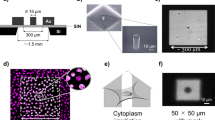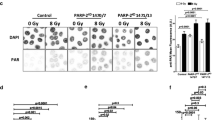Abstract
Synthesis of p53 and WAF1 (p21) proteins was studied in cells of patients with Nijmegen breakage syndrome (NBS) and of patients with ataxia telangiectasia (AT), as well as in normal cells with respect to their response to ionizing radiation (IR). In the NBS cells, the p53 protein was progressively accumulated with increasing radiation dose and reached the maximum 2 h after exposure to radiation at a dose of 5 Gy. The amount of p53 protein was consistently lower than that in normal cells, which was correlated with low content of the WAF1, the protein regulated by p53 at the level of transcription. Suboptimal induction of p53 observed in NBS cells was also characteristic of the AT cells, though the quantitative parameters of the protein synthesis in AT cells were intermediate relative to those in normal and NBS cells. In four NBS lines, the time schedule of p53 synthesis was similar to that observed in normal cells, whereas in AT cells, induction of p53 was significantly delayed as compared to control. In response to irradiation, the amount of p53 protein synthesized in patients with AT and NBS was significantly lower than that in normal cells. The results obtained, as well as the previously published medical and genetic evidence, suggest that the two diseases are of different origin and different genes are responsible for their development.
Similar content being viewed by others
REFERENCES
Weemas, C.M., Smeets, D.F., and van der Burgt, C.J., Nijmegen Breakage Syndrome: A Progress Report, Int. J. Radiat. Biol., 1995, vol. 66, pp. 185-188.
Jaspers, N.G.J., Taalman, R.D., and Baan, S., Patients with Inherited Syndrome Characterized by Immunodeficiency, Microcephaly and Chromosome Instability: Genetic Relationship to Ataxia Telangiectasia, Am. J. Hum. Genet., 1988, vol. 42, pp. 66-73.
Taylor, A.M., Metcalf, J.A., Thick, J., and Mark, Y.F., Leukemia and Lymphoma in Ataxia Telangiectasia, Blood, 1996, vol. 87, pp. 423-438.
Matsuura, S., Weemas, C., Smeets, D., et al., Genetic Mapping Using Microcell-Mediated Chromosome Transfer Suggests a Locus for Nijmegen Breakage Syndrome at Chromosome 8q21-24, Am. J. Hum. Genet., 1997, vol. 60, pp. 1487-1494.
Stumm, M., Gatti, R.A., and Ries, A., The Ataxia-Telangiectasia-Variant Genes 1 and 2 Are Distinct from Ataxia-Telangiectasia Gene on Chromosome 11q23.1, Am. J. Hum. Genet., 1995, vol. 57, pp. 960-962.
Hartwell, L.H. and Kastan, M.B., Cell Cycle Control and Cancer, Science, 1994, vol. 266, pp. 1821-1828.
Cox, L.S. and Lane, D.P., Tumor Suppressors, Kinases and Clamps: How p53 Regulates the Cell Cycle in Response to DNA Damage, BioEssays, 1995, vol. 17, pp. 501-508.
Nigg, E.A., Cyclin-Dependent Protein Kinases: Key Regulators of the Eukaryotic Cell Cycle, BioEssays, 1995, vol. 1, pp. 471-408.
Deng, C., Zhang, P., Harper, J.W., et al., Mice Lacking WAF1CIP1/WAF1 Undergo Normal Development, But Are Defective in G1 Checkpoint Control, Cell (Cambridge, Mass.), 1995, vol. 82, pp. 675-684.
Brugarolas, J., Chandrasekaran, C., Gordon, J.I., et al., Radiation-Induced Cell Cycle Arrest Compromised by WAF1 Deficiency, Nature, 1995, vol. 377, pp. 552-557.
Khanna, K.K. and Lavin, M.F., Ionizing Radiation and UV Induction of p53 Protein by Different Pathways in Ataxia-Telangiectasia Cells, Oncogene, 1996, vol. 12, pp. 3307-3312.
Artuso, M., Esteve, A., Bresil, A., et al., The Role of the Ataxia Telangiectasia Gene in the p53, WAF1/CIP1 (WAF1)-and GADD45-Mediated Response to DNA Damage Produced by Ionizing Radiation, Oncogene, 1995, vol. 11, pp. 1427-1435.
Canman, C.E., Wolff, A.C., Chen, C.-Y., et al., The p53-Dependant G1 Cell Cycle Checkpoint Pathway and Ataxia Telangiectasia, Cancer Res., 1994, vol. 54, pp. 5054-5058.
Antoccia, A., Ricordy, R., Marachio, P., et al., Chromosomal Sensitivity to Clustogenic Agents and Cell Cycle Perturbations in Nijmegen Breakage Syndrome Lymphoblastoid Cell Lines, Int. J. Radiat. Biol., 1997, vol. 71, pp. 41-49.
Westphal, C.H., Rowan, S., Schmaltz, C., et al., Atm and p53 Cooperate in Apoptosis and Suppression of Tumorigenesis, but not in Resistance to Acute Radiation Toxicity, Nat. Genet., 1997, vol. 16, pp. 397-401.
Author information
Authors and Affiliations
Rights and permissions
About this article
Cite this article
Balmukanov, T.S., Aitkhozhina, N.A., Matsuura, K. et al. Specific Features of p53 Protein Induction after Ionizing Radiation in Cells of Patients with Nijmegen Breakage Syndrome. Russian Journal of Genetics 38, 824–827 (2002). https://doi.org/10.1023/A:1016352007643
Issue Date:
DOI: https://doi.org/10.1023/A:1016352007643




